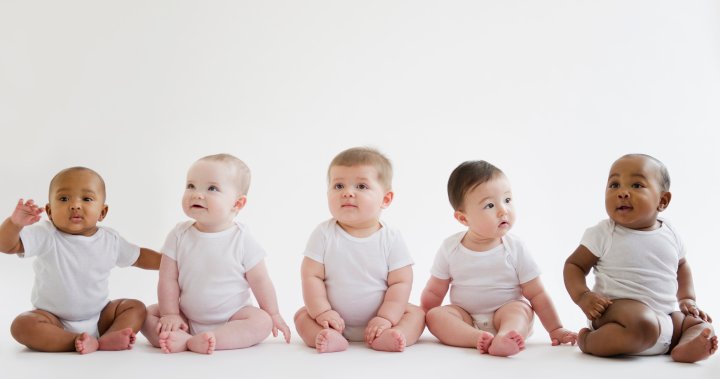The Trump administration is reportedly exploring ways to reverse America’s declining birthrate by offering incentives for larger families, potentially including a $5,000 “baby bonus” for new mothers.
That’s according to a report published Monday by the New York Times, saying that U.S. President Donald Trump is looking to address the country’s falling birth rate; it comes after he recently dubbed himself the “fertilization president.”
One idea being considered by the White House includes setting aside scholarships for married applicants or parents, the Times reported. Another would pay a baby bonus to new mothers, and a third would fund menstrual‑cycle education to help women better track fertility, according to the article.
On Tuesday, when reporters asked about the report of White House plans to give parents bonuses for having a child, Trump backed the idea.
“Sounds like a good idea to me,” Trump said.
How low are U.S. birth rates?
The U.S. birth rate has been steadily falling for decades.
In 1990, the average American woman had about 2.1 children — the level needed to keep the population steady. By 2023, that number had dropped to 1.62, according to the U.S. Centers for Disease Control and Prevention (CDC).
This trend isn’t limited to the U.S. — countries like South Korea, Italy, Japan, Spain, France and Canada are facing similarly steep drops in birth rates.
In 2023, Canada’s fertility rate dipped to an all‑time low of 1.26 children per woman, cementing its status as one of the world’s “lowest‑low” fertility countries, according to Statistics Canada.
“It’s a worldwide challenge. Even the high reproductive places are dropping,” explained Arthur Caplan, head of the division of medical ethics at the NYU Grossman School of Medicine in New York City.
“And it looks like many places are now thinking, ‘Well, we don’t have enough kids, we don’t have kids to take care of the elderly and we don’t have enough of a tax base,’” he said.

How are countries trying to tackle low births?
Studies have shown fertility rates are falling worldwide for multiple reasons including, women delaying childbearing to pursue education and careers, the high cost of housing and child-rearing, greater access to contraception and family planning and shifting social norms around family size.
Caplan argues that low fertility also stems in part from an outlook on the future — worries about the economy, cultural instability, food security and climate change all play a role.

Get weekly health news
Receive the latest medical news and health information delivered to you every Sunday.
In response to falling birth rates, some countries have begun getting creative to encourage more babies.
For example, Tokyo is in the process of rolling out a four-day workweek in an attempt to improve work-life balance and tackle Japan’s record-low fertility rate.
Hong Kong, with one of the lowest birth rates in the world, offers parents a newborn bonus of HK$20,000 (around CAD$3,580), along with a monthly child allowance.
In 2019, Hungary introduced a loan of around 30,000 euros to newlyweds. If they have three children, the loan is forgiven.
And now the U.S. may be considering a similar cash incentive.
However, Caplan cautions that these incentives can carry darker overtones. He argues that when policymakers frame declining fertility as a crisis worth fixing with cash, they often reveal deeper anxieties about race and ethnicity, not just population size.
“If you really cared about babies,” he points out, “it would be hard to justify policies that deport children or young immigrants at the rates we see today.”

A 2023 study in Global Health and Medicine argued that policies strengthening family life, such as paid parental leave, quality child care and flexible work arrangements, help bump up birth rates by making it easier to juggle work and kids.
By contrast, the study argued, one-off “baby bonuses” or small cash transfers only spark brief upticks.
Since they barely cover the real costs of parenting, these payments tend to shift the timing of births rather than increase the total number of children couples have, the researchers said.
“This idea of a baby bonus, giving somebody $5,000, is ridiculous, it won’t change behaviour at all,” Caplan said. “And we know that because many countries have tried it — Taiwan, Italy, Japan — but it has not worked. Nobody has more kids with a small baby bonus.”
He points out that raising a child can be very expensive — about CAD$293,000 from birth to age 17 in Canada, according to Statistics Canada, and roughly USD$237,482 from birth to 18 in the U.S., per a 2023 report.
“With this baby boom idea, they did not mention affordable daycare, job flexibility, working from home, parental leave, better pay,” he said.

Subsidizing childbearing isn’t new — many developed nations already offer perks like extended parental leave. Canada provides up to 18 months of paid leave and access to subsidized daycare, while Sweden and Norway also boast generous leave programs.
Yet, despite these supports, fertility rates keep falling.
Caplan argues this isn’t surprising: there’s no single solution.
“If you really want to boost fertility,” he says, “you need to convince people that tomorrow will be better than today.”
“But even then, childbearing decisions in the past were shaped in eras of agriculture, larger families, and higher child mortality — conditions that simply don’t apply anymore. We may never see families sizes that big again.”






